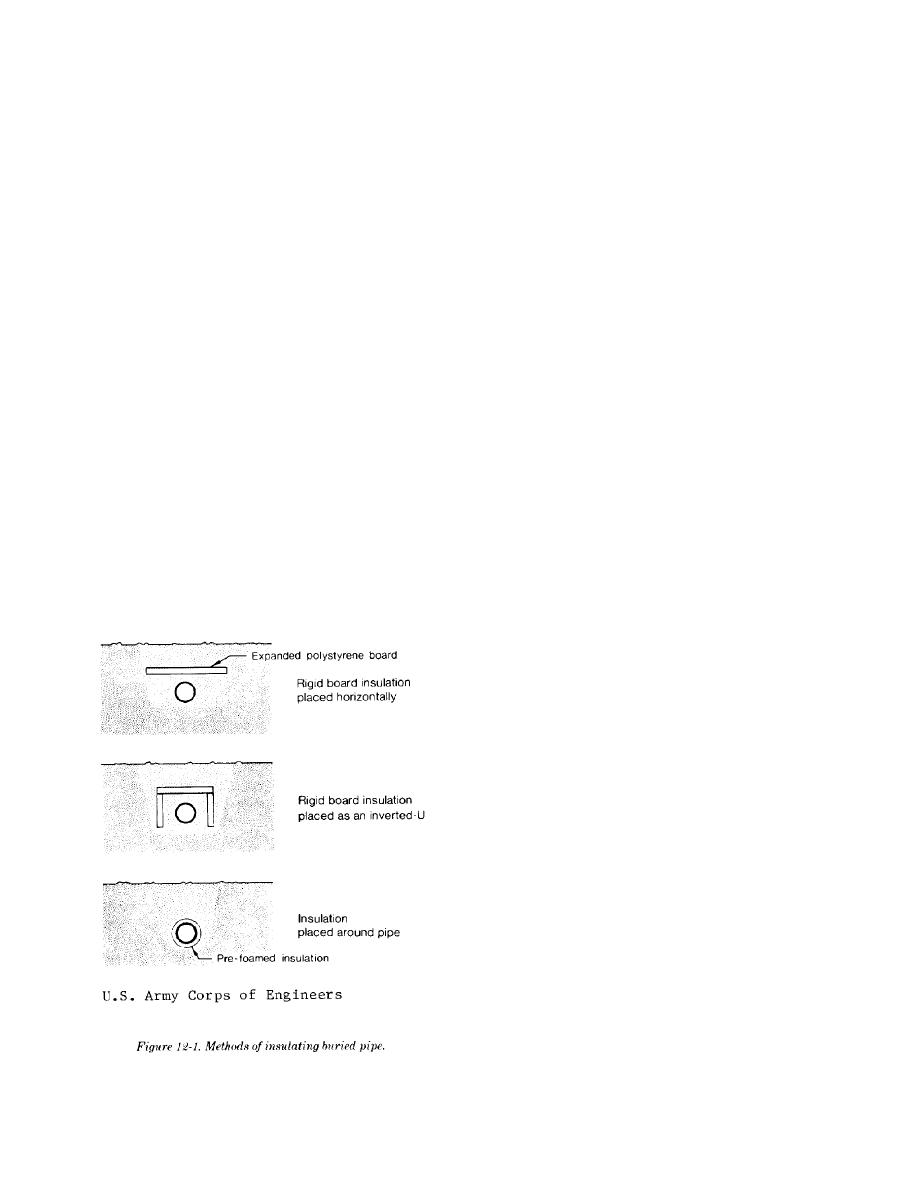
TM 5-852-5/AFR 88-19, Volume 5
c. Deep burial. Deeper pipes will experience less
bare pipes and fittings and board insulation, is often
extreme ambient temperatures, lower maximum
less expensive (for materials) than use of prefabri-
rates of heat loss and a longer safety factor time for
cated insulated pipe; however, the construction cost
freezing. However, the heating period will be
will be higher and the effectiveness of the insulation
longer, and pipes installed in permafrost will require
is lower than direct insulation on the pipes. The
freeze-protection all year.
board method has been used where the soils under-
lying the pipe are frost-susceptible, since frost
12-5. Physical methods for reducing heat
penetration beneath the pipes can be prevented by
loss.
the insulation board. The necessary thickness and
The primary physical method of reducing heat loss
width of the board increases for shallower pipes and
is insulation. It is impractical to prevent gound
deeper frost penetration, such as dry soils or rock.
moisture, humidity or water from pipe failures from
The relative economics, compared to that for insu-
reaching the insulation and, since moisture content
lated pipes, is improved when pipes are placed in a
is a key fctor in determining the thermal
common trench under a board and when warm
performance of insulations, only near-hydrophobic
sewer or central heating lines are included. Gener-
insulations will be used. Even these insulations will
ally, the insulation should be a minimum of 4 feet
usually require some physical and moisture
wide for a single pipe, and the thickness will be
protection.
determined by the proposed depth of burial and the
a. Amount of insulation. An economic analysis to
expected or calculated frost penetration. In terms of
balance heating and insulating costs must be per-
reducing frost penetration, two inches of polysty-
formed to determine the minimum amount of insu-
rene foam insulation (k = 0.02 BTU/hrftF) is
lation that is required (see para 12-9i) and will
roughly equivalent to 4 feet of sand or silt or 3 feet
include factors, such as the freeze-up time, the max-
of clay cover over the pipe. The heat loss and trench
imum rate of heat loss and practical dimensional
width will be reduced by placing the insulation in an
considerations. Heat loss estimates for pipe systems
inverted U. The design example in paragraph 12-9c
must consider exposed sections of pipes, joints and
illustrates frost penetration calculations beneath an
appurtenances, and thermal breaks such as at pipe
insulation board.
anchors. For example, a 5-inch gate valve has a
surface area equivalent to 3 feet of bare pipe. If this
valve were left exposed it would lose as much heat
as about 200 feet of 5-inch pipe insulated with 2
inches of polyurethane insulation and freezing would
occur at the valve first. To ensure a safe design, the
thermal resistance around appurtenances must be
1.5 times that required around the adjacent pipe
sections.
b. Location of insulation. Heat loss and the
volume of materials will be reduced by minimizing
exposed surface area. This is most important for
above-ground pipes and facilities. Insulation is most
effective when it is placed directly around the source
of heat. These characteristics are illustrated by the
simple shapes in figures 12-2 and 12-3. Where there
is an air space, the thermal resistance of the pipe air
film can be quite significant and must be considered.
For a single pipe, insulation is best applied in an
annulus directly around the pipe. Heat loss from
several pipes in a compact utilidor is less than that
of the same number of separate pipes insulated with
the same total volume of insulation. Heat loss will
also be reduced and freeze protection improved by
installing one water pipe inside of a larger one,
rather than using two separate pipes. This technique
is applicable for freeze protection of small-diameter
recirculation pipes used to maintain a flow in supply
12-2



 Previous Page
Previous Page
